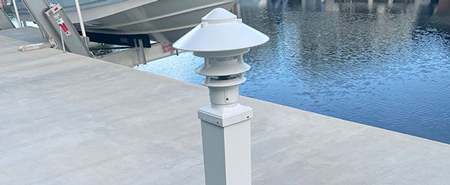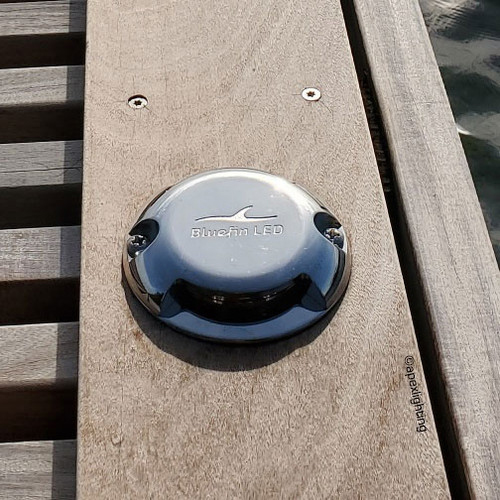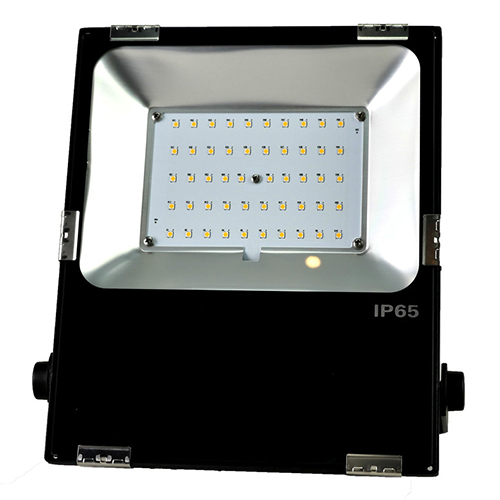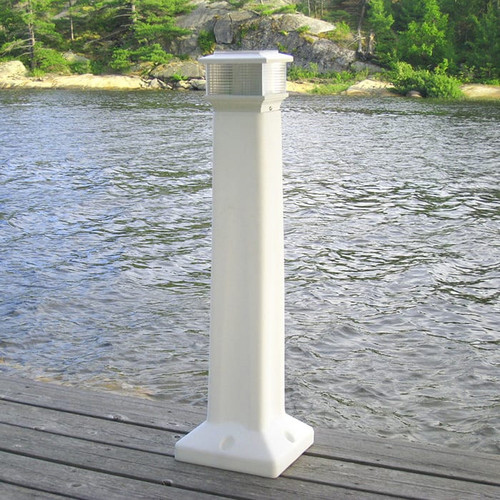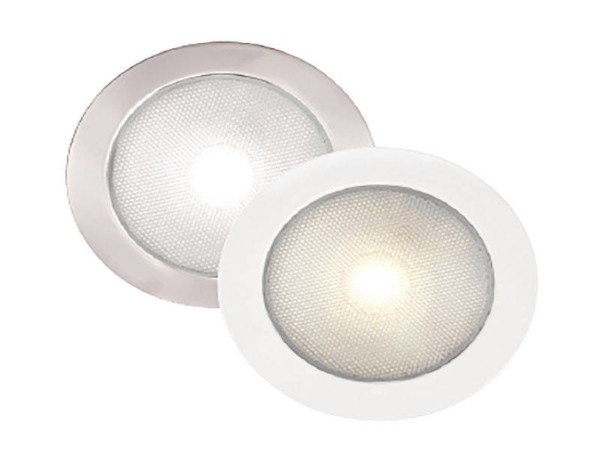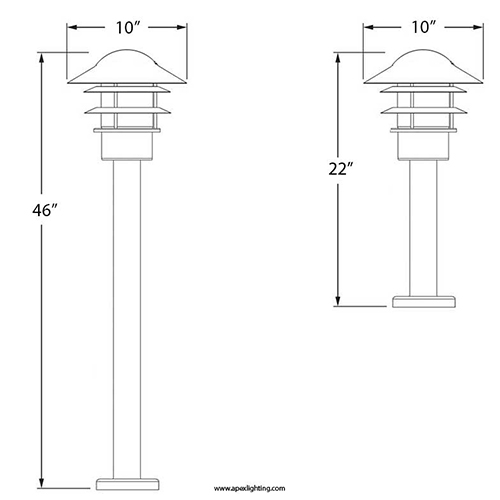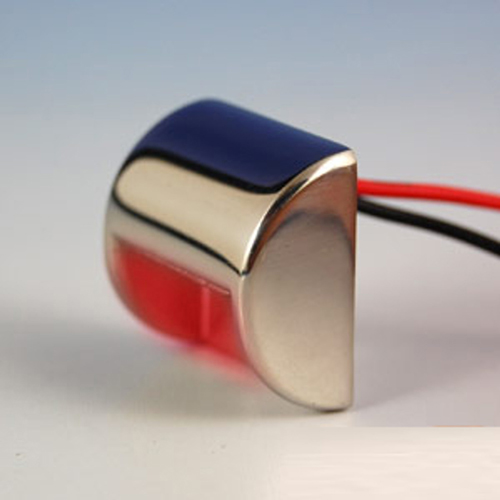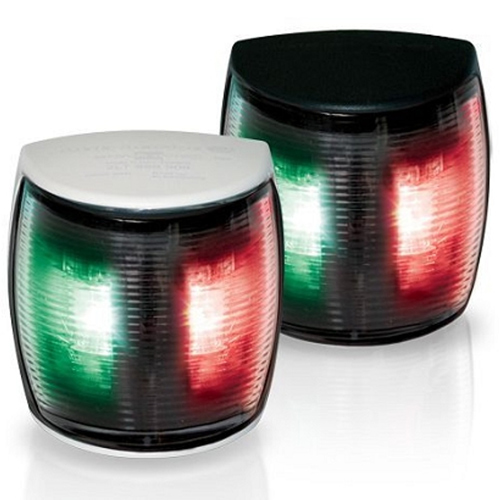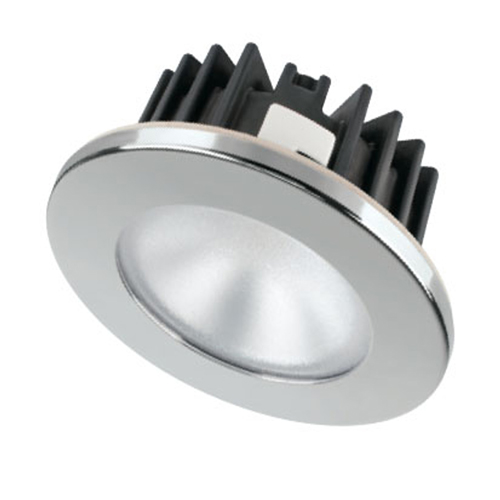Exploring Dock Light Fixtures: Top 40 FAQs Answered
Posted by Apex Lighting on 4th Aug 2023
Question 1: What Are Dock Light Fixtures?
Dock light fixtures are outdoor lighting devices that play a crucial role in enhancing visibility and safety in outdoor environments.
Specifically, they provide illumination during nighttime and low-light conditions, on and around docks, piers, and waterfronts, drawing power from various sources, including solar batteries and the electricity grid.
These fixtures are typically mounted on poles, walls, ceilings, or structures near or on the dock itself to illuminate various spaces. They also come in a variety of sizes, shapes, and designs,which enables their different applications.
One example includes the 3.75" Round LED Pathway Light from Apex Lighting. It’s a steel-cased dock light designed to illuminate pathways with a warm 600-lumen light and tolerate exposure to water splashes, wind, heavy rain, and impact from foot traffic.
Another example is the cubical Solar Sentinel with LED Light. It’s a solar-powered dock light designed for off-grid lighting of pilings or support structures in or around waterfront areas.
As such, this cubical dock light features a top-side solar panel, a large in-built 12-hour rechargeable battery, and an ingress protection (IP) coating to cope with constant exposure to saltwater, rain, and dust (typical elements of a marine environment).
Question 2: What Do Dock Light Fixtures Do?
A lot goes on in a typical docking environment. There are guests boarding and disembarking vessels, boats entering and leaving the docking area, and stevedores loading and unloading cargo.
For a smooth and safe operation of all these activities, ample visibility is essential and that’s what dock light fixtures do.
They illuminate travel lines for boats as they enter and leave the dock area, especially at night or during low-visibility conditions, such as fog and heavy rainfall. This averts collisions and possible obstacle-related accidents.
They light up pathways and waterfronts for the aesthetic appeal and the convenience it brings such as easy and safe movement for your guests and extended working hours for on-the-clock stevedores.
A dock light fixture such as the MegaLED 50W Slim A/C Flood Light produces an impressive 6,500-lumen illumination, which is a high light output that effectively lights up any dock area to ensure safety.
Generally, marine lights go as high as 10,000 lumens, which places 6,500 lumens within the higher end of the brightness spectrum.
“The shipment arrived quickly. Easy to install. They look amazing.” — Anonymous, Verified Buyer
Question 3: What Are the Benefits of Dock Light Fixtures?
It’s startling to think that a simple misstep around your dock’s edge is enough to cause a serious accident for you, your guests, and anyone within that environment.
This is why it’s essential to have constant visibility around your waterfront to minimize the chances of such mishaps, which is the main benefit of dock light fixtures.
A strategically-placed fixture helps to avert visibility-related dangers, including collisions between vessels, slipping, and misaligned equipment such as loading ramps.
For example, a flood light near the entrance and exit of a dock area helps vessels identify obstacles and designated access points for safe maneuvering in and out of the dock.
Alternatively, a pathway light provides your guests with a sense of direction and keeps them from venturing into hazardous areas within your waterfront, such as drop zones.
Another key benefit of dock light fixtures is productivity. These lights extend outdoor working hours to accommodate nighttime, without compromising safety.
They provide uninterrupted visibility for vehicles and personnel, allowing them to carry on working, whether it’s loading and unloading cargo or maintenance duties. This boosts effectiveness while ensuring safety.
Dock light fixtures also enhance the aesthetic of your dock area and make it more appealing to your guests. A classic example of this phenomenon is the allure of a pathway featuring double rows of illuminating fixtures such as the Lumitec Scallop Surface Mount Pathway Light.
It’s the sort of scenic view that makes for an exceptional boating experience and one that’s especially facilitated by this particular dock light with its full color-changing RGBW bulbs.
Question 4: How Do Dock Light Fixtures Work?
Dock light fixtures work by converting electrical energy (current) into light energy.
They typically consist of a light source (such as an LED or incandescent bulb), a reflector, and a lens, which work together in the following process.
- An electrical current flows through the bulb, which heats up to produce light.
- The reflector helps to magnify and direct the light toward a desired area.
- The lens helps to control light dispersion.
Different lens configurations, such as narrow or wide beam angles, either concentrate the light beam in a specific direction or disperse it over a wider space. A classic example of this lens configuration is in the different light patterns of floodlights and spotlights.
Question 5: What Types of Dock Light Fixtures Are Available?
There are several types of dock light fixtures available on the market with distinct technical designs for their operation. These include:
- LED dock lights: These lights use a light-emitting diode (LED), which produces light when an electric current passes through it. They’re highly energy-efficient and ideal for lowering your energy costs while providing constant illumination.
- Incandescent dock lights: These dock lights feature traditional incandescent bulbs to provide illumination. As such, they emit a warm and yellowish light that’s excellent for creating a cozy atmosphere around your dock.
- Halogen dock lights: These lights contain a halogen gas-filled quartz or glass envelope, which produces a brighter illumination compared to traditional incandescent bulbs.
- Solar-powered dock lights: These lights feature built-in solar panels that charge during the day for nighttime use, for instance, the Solar Sentinel with LED Light. As such, they’re an excellent option for off-grid locations and lowering your energy costs.
Apex Lighting carries a large selection of dock lights exclusively from top-tier brands. You’re sure to find something for your needs, whether it’s a touch of class with the Pagoda LED Piling Light or brilliance with the halogen AC LED Flood Light 50W.
Question 6: Can Dock Light Fixtures Be Used for Other Purposes Besides Lighting Docks?
Yes, your dock light fixture also serves other purposes, for instance, in marinas, piers, and other waterside structures, where it provides illumination for walkways, parking areas, and loading zones.
This versatility stems from the fixture's robust construction, designed to withstand diverse environmental conditions, as indicated by its rating on the ingress protection (IP) scale.
Typical dock light IP ratings include:
- IP67: This signals complete protection from dust, resistance to 12.5mm of focused water pressure from all directions, and a submersion capability of up to 3.2 feet.
- IP68: This means complete protection from dust, resistance to 12.55 mm water jets from any direction, and a submersion capability of up to 9.8 feet.
As a result, your light fixture works optimally in applications outside docks such as industrial settings, which are prone to dust, and outdoor public spaces, which are exposed to heavy rain and snow.
Question 7: What Features Should I Look For in a Dock Light Fixture?
First, look for excellent waterproofing to protect your dock lights from various environmental conditions and ensure longevity.
Your fixture will be coming up against dust, rain, wind, snow, and hailstorms. It, therefore, needs a solid, air-tight construction to resist intrusion by these elements and protect the delicate internal components.
An IP68 rating is the minimum acceptable standard for excellent waterproofing as it ensures complete protection from dust, resistance from omnidirectional water jets, and even a submersion of 9.8 feet.
The next feature to look for in a dock light fixture is the quality of the housing.
Your fixture will be subjected to the corrosive effects of ocean saltwater and needs housing made of rust-proof and marine-grade materials, for example:
- Stainless steel: This material is highly resistant to corrosive saltwater due to its unique composition that includes chromium, known to form a protective oxide layer on the surface when exposed to oxygen.
- Marine-grade aluminum: This material is a specially formulated alloy, designed to withstand saltwater. It’s, therefore, an ideal housing choice for your light fixture that ensures longevity.
- Polycarbonate lenses: This material is 250 times tougher than glass and an excellent choice for protecting your fixture against corrosive saltwater and extreme weather.
Question 8: What Are Some Common Problems With Dock Light Fixtures?
Common problems associated with dock light fixtures include issues with wiring, bulbs burning out, and damage from harsh weather conditions.
The first two issues are interconnected with faulty wiring exposing your bulbs to an intermittent power supply, which leads to flickering and eventual burning out. As such, it’s critical that you follow the manufacturer's guidelines during installation.
Alternatively, hiring a professional ensures a proper light fixture that’s free of wiring mistakes such as loose connections and inadequate insulation.
Apex Lighting is one such professional, offering installation services within the Fort Lauderdale, Florida area for various size projects, from small residential docks to large marina and resort dock lighting setups.
The third issue with your light fixtures is water damage. This is usually a gradual process stemming from substandard maintenance.
A typical example is where insufficient cleaning allows dust and debris to accumulate on your dock lights, weakening and eventually cracking their water-tight seals. This creates an opening for rain and saltwater to penetrate your fixtures and cause damaging electrical shorts.
Therefore, it’s important to regularly clean and inspect your fixtures to ensure optimal functioning without improper connections or clogging from dust and debris.
Question 9: How Do I Maintain My Dock Light Fixtures?
Proper maintenance of dock light fixtures prolongs their lifespan and ensures optimal functioning. Here are four critical maintenance tips:
- Clean your fixtures regularly to remove dirt, grime, and debris that reduce brightness and damage the watertight seals on your device.
- Check your connections and wiring to ensure adequate insulation, a secure connection, and functioning bulbs. Replace your bulb if it’s fused or damaged.
- Inspect your fixture’s housing for cracks or damages and check their hinges and clamps. Lubricate the moving parts to keep them smooth and replace any cracked housing.
- Schedule routine maintenance checks with a professional to identify any potential problems early and enable timely intervention.
Question 10: How Long Do Dock Light Fixtures Typically Last?
Dock light fixtures typically last for a long time, depending on the type of fixture. However, the conditions to which they’re subjected certainly influence their lifespan in terms of whether or not they achieve their expected shelf life.
For example, LED lights have a lifespan of 25,000 hours (2.85 years), incandescent lights last for 1,500 hours (less than a year), and fluorescent lights last 15,000 hours (1.78 years).
However, whether these fixtures complete their respective shelf lives depends on environmental factors such as their exposure to heavy machinery (placement) and maintenance frequency.
It’s common for dock lights to sustain physical damage from moving machinery such as forklifts if mounted insecurely in a high-activity area, for instance, without sufficient ground clearance or shielding.
Meanwhile, substandard maintenance allows grime and dirt to accumulate and compromise a fixture’s housing. This creates an opening for liquids such as rain and seawater, which cause your dock light to fail before its designated lifespan.
Question 11: Do Dock Light Fixtures Come With a Warranty?
Yes, dock light fixtures come with a warranty to cover possible defects in materials and workmanship, for example, inadequate weatherproofing, damaged housing, and faulty components.
This serves as a guarantee from the manufacturer that your dock light fixture is reliable and conforms to industry standards of quality. As such, a malfunction during the warranty period bears a responsibility for the manufacturer to rectify or replace the dock light.
A common malfunction scenario is when droplets of rainwater seep into your dock light fixtures during the warranty period.
This suggests a defect in weatherproofing and entitles you to rectification by the manufacturer or a replacement, provided there was no interference with the device during this period.
The warranty period varies depending on the manufacturer and model of your light fixture, but it typically ranges between one and three years, as with the Mantis Dock Light Single from Apex Lighting.
Question 12: Are LED Dock Light Fixtures Better Than Traditional Incandescent Ones?
Yes, LED dock light fixtures are better because they use LED bulbs, which are 80% more efficient than incandescent bulbs.
This greater efficiency comes from the higher conversion rate of electrical energy into visible light that defines LED bulbs, which don’t lose energy via the heat-dissipating filament of incandescent bulbs.
LED dock light fixtures also have a longer lifespan than incandescent dock lights.
Your LED dock light typically lasts 25,000 hours under optimal conditions such as proper placement and sufficient maintenance. In comparison, incandescent bulbs last 1,500 hours or less than a year under ideal conditions.
This difference comes down to the heat-generating filament of incandescent bulbs. Over time, high heat degrades this filament (tungsten metal) and causes the bulb to burn out faster than an LED fixture.
LED dock lights don’t have a filament and instead use a light-emitting diode, which eliminates the risk of heat-related failure and the need for frequent replacements.
Question 13: How Bright Should My Dock Light Fixtures Be?
The optimal brightness level for dock light fixtures is one that provides sufficient illumination and visibility of your dock area, equipment, and materials without glaring or blinding. It strikes a perfect balance between visual comfort and effective lighting to ensure a productive and safe environment.
However, the exact luminosity depends on several factors such as:
- The size of your dock
- The area to be illuminated
- The purpose of illumination
If the dock space to be illuminated is a large, high-activity site, for example, a loading zone, high luminosity is necessary to ensure sufficient visibility of the heavy machinery and equipment as well as the safety of the workers.
On the other hand, if the dock area is small and the spot to be illuminated is used for recreational purposes, such as fishing or docking boats, low luminosity is preferable to create a soothing and relaxing ambiance.
A recommendable rule of thumb is to seek out 1,600-lumen fixtures for illuminating small dock spaces without glare and brighter lights (above 1,600 lumens) for more extensive sites with more activity, such as loading zones.
Question 14: What Are the Energy Requirements for Dock Light Fixtures?
The energy requirements for your dock lights vary depending on your type of fixture and its wattage. Different fixture designs have varying wattages, and the higher the wattage, the greater the energy demands.
Traditional incandescent dock lights, for example, typically require 80% more energy than LED dock lights, which consume lower wattages and are more energy-efficient. So, for a 60-watt incandescent dock light of 800 lumens, an LED fixture requires 12 watts for the same luminosity.
This difference stems from how incandescent lights produce light, by passing an electric current through a resistive filament that generates heat and light. LED fixtures use diodes that produce visible light with little energy lost via heat.
That said, to determine the energy requirements of your dock light fixture, check the product specifications and note its maximum voltage and rated wattage.
Alternatively, consult a lighting professional to guide you through the best dock light fixture for your power outlet and the most efficient wattage for your space. This entails its square-foot size and designation; for instance, is it a work area?
Question 15: Are Dock Light Fixtures Easy to Install?
Yes, dock light fixtures are generally easy to install, especially if they come with step-by-step installation instructions that include their energy requirements. This is the maximum voltage they can handle and their type of electric current (direct or alternating).
Most fixtures are plug-and-play with installation-guiding features such as color-coded wires, quick-connect terminals, and pre-attached power cords.
As such, assembling them requires no special tools and knowledge above what’s featured in the instruction manual. In certain cases, such as with the wire-free Solar Sentinel with LED Light, installation is nothing more than mounting the fixture atop your dock.
Even so, specialized fixtures such as underwater dock lights tend to be more complex due to their submerged nature. As a result, they require professional installation to ensure proper functioning and avoid potential issues such as short circuits and incorrect depth placement.
Question 16: Can I Install Dock Light Fixtures Myself or Do I Need a Professional?
It’s possible to install dock lights yourself if you have the necessary knowledge and experience. Some fixtures come marketed as “Build Your Own” for individuals with a passion for DIY projects.
These individuals typically understand basic electrical wiring principles and tools, electrical safety guidelines and codes, and are experienced in assembling electronic devices including light fixtures.
Without this background, it’s better to hire a professional electrician for the installation to ensure proper installation and safety.
A licensed professional will assess your electrical requirements properly, install the fixtures correctly, and ensure they are grounded properly to reduce the risk of electrical shock or damage to the fixtures.
They also ensure your lights comply with regulations such as the Backlight, Uplight, and Glare (BUG) standards for outdoor light fixtures above 6,200 lumens.
Warning: Remember, even though many dock light fixtures are easy to install, working with electricity can be dangerous. Always take appropriate safety precautions and don't hesitate to call a professional if you're unsure about any step of the process.
Question 17: Can My Dock Light Fixtures Cause Light Trespass?
Yes, without proper positioning and aim, your dock light fixture has the potential to cause light trespass.
This occurs when light spills over to adjacent properties rather than solely illuminating your dock space, which is particularly typical with broad-beam floodlight dock fixtures. The intrusion results in glare, reduced visibility for your neighbors, and disturbance to nearby nocturnal wildlife.
The key to preventing light trespass is conducting a lighting survey of your property before installing your dock lights. This enables you to map out all the high-risk areas, such as high grounds and boundaries.
With this information, it becomes easier to select the least intrusive spots to set up your dock fixtures before aiming them at the ground or installing shields to ensure zero trespass.
The second approach is to turn off the lights when not in use. This not only eliminates any chance of light intrusion but also helps you conserve energy and lower your electricity bills.
An effective way of using this strategy is incorporating motion sensors into your dock fixture system to activate the lights only when needed, for example, when guests and workers approach them.
Question 18: Are There Any Safety Concerns With Using Dock Light Fixtures?
Yes, there are safety concerns with using dock light fixtures. These entail light pollution and electrical insulation.
A particularly sensitive area for light pollution and its impact on safety is dock loading zones. These are high-activity areas with heavy equipment and loads maneuvering different sections, necessitating constant visibility.
Excessive glare from a poorly positioned fixture increases the risk of mishaps such as collisions and equipment misalignment and poses a hazard for people and vessels using the dock.
Electrical insulation is especially critical for underwater dock light fixtures, where a poorly insulated wire exposes dock users to electrical shock and injury. It’s therefore critical to have licensed and insured electricians install your new lights in accordance with electrical codes and regulations.
Ground Fault Circuit Interrupter (GFCI) Protection regulation, for instance, requires a fault monitor that quickly shuts power if an imbalance occurs. This serves as an extra layer of protection against electric shock after proper insulation.
Question 19: What Types of Bulbs Are Used in Dock Light Fixtures?
Dock light fixtures use a variety of bulbs, including traditional incandescent, LED, and halogen. This assortment is due to the unique benefit each design offers different applications, for instance:
- LED bulbs: They’re currently the most efficient and lasting of all dock light bulbs, making them ideal for round-the-clock or all-night illumination without high energy costs. Their low heat output gives these bulbs up to 25,000 hours or 2.85 years.
- Incandescent bulbs: They offer a warm, ambiance-setting light that’s ideal for certain sections within your dock, for instance, recreational spaces with outdoor seating. However, their low efficiency and short lifespan of 1,500 hours limit them to occasions.
- Halogen bulbs: They produce a crisp, clear white light that’s excellent for accurate color representation. This makes halogen bulbs ideal for dock spaces that need color perception, such as loading zones where cargo identification entails color-coded labels.
Even so, halogen bulbs are a type of incandescent bulb, which typically last 1,500 hours. As such, they’re not as efficient as LEDs and not suitable for round-the-clock lighting.
Question 20: How Do I Choose the Right Size Dock Light Fixture for My Dock?
When choosing the right size dock light fixture for your dock, consider the size of your dock and the amount of lighting that you require.
This entails measuring the length and width of different sections of your dock to determine the number of fixtures you need based on your lighting requirements.
The general rule of thumb is 0.5–1.0 footcandles per square foot, which translates to between 5–10 lumens per square foot. So, for a standard 160-square-foot terminal platform, for example, you need between 800–1,600 lumens, depending on your preference.
Therefore, the right size fixture, in this case, is possibly a single dock light producing the entire 1,600 lumens or multiple fixtures that collectively provide the desired luminosity.
Question 21: How Do I Properly Aim and Position My Dock Light Fixture?
Proper aiming and positioning of your dock light fixtures solve the most fundamental lighting problem, which is glare.
A well-aimed dock fixture directs its light rays away from the eyes of passersby and toward the key areas you wish to illuminate, possibly, corners, pathways, entryways, and dock surfaces.
This creates comfortable visibility around the light fixtures and especially from a distance, where glare is most noticeable. However, aiming your lights away from direct eye contact has different implications for the various mounting styles of dock fixtures.
- Pole and wall-mounted dock lights: These need to be angled downwards at a 45-degree angle to direct the light rays downwards and away from people’s eyes.
- Bollard and pilling fixtures: These require retro-fitted shades, for some designs, to prevent or minimize the density of uplight, which causes glare. Fixtures, such as the Aluminum Round Post Dock Light, feature a full cut-off top design that prevents such light emission.
- Surface-mounted dock lights: These fixtures are generally directional but must be positioned to orient their light rays parallel to the ground and away from direct eye contact.
“This light is beautiful. It is a really great addition to our newly remodeled dock.”— Anonymous, Verified Buyer
Question 22: Can Dock Light Fixtures Be Used in Saltwater Environments?
Yes, your dock light fixtures are operable in saltwater environments, but they must be specifically designed for this purpose through their material construction and seals.
Saltwater is extremely corrosive due to high concentrations of chloride ions, which contribute to the breakdown of metal surfaces in the presence of oxygen through oxidation or rusting.
Rust leads to cracks and openings within your fixture’s housing, exposing the delicate internal components to water damage and eventual failure. This is why fixtures designed for saltwater environments have protective features such as marine-grade stainless steel housing.
Another solution to the corrosive effects of saltwater is a powder-coated aluminum build, as with the Pagoda LED Piling Light from Apex Lighting.
Aluminum is inherently resistant to corrosion due to its naturally-occurring oxide layer. So, adding a layer of powder to this metal enhances its resilience further by creating a second barrier, which limits its exposure to the corrosive saltwater chloride ions.
Before subjecting your dock light to saltwater environments, verify that its design features similar protective elements. Also, inspect and ensure that the fixture is in optimal working condition. So, for instance, no cracks within the housing or damage to the watertight seals.
“The Pagoda Led Piling Lights (white) Are Very Well Constructed! Was Very Easy To Install.I Am Very Happy With My Purchase.Thank You For The Great Service And Communication.” — David Mc Q., Verified Buyer
Question 23: What Is the Lifespan of LED Dock Light Fixtures?
Typically, your LED dock lights have an extended lifespan of 25,000 hours (2.85 years), which is significantly longer than traditional incandescent bulbs of 1,500 hours (less than a year) and fluorescent lights of 15,000 hours (1.78 years).
This longevity is due to the low-heat approach LED bulbs use to convert electrical energy to visible light. A low-heat output places less strain and wear on your fixture’s internal components, such as LED microchips, and facilitates their lengthy service life.
However, whether your fixture achieves its full 25,000-hour service life depends on your placement and the environment you subject it to.
Placing your fixture within reach of heavy equipment in a high-activity zone, for instance, increases the risk of physical damage and failure to reach its projected lifespan.
Alternatively, exposing your LED dock lights to saltwater without the necessary protective features such as rust-proof housing and watertight IP68 seals also impacts your fixture’s lifespan.
Question 24: Are There Any Environmental Concerns With Using Dock Light Fixtures?
Yes, there are environmental concerns associated with using dock light fixtures, particularly around the creatures of the night.
We never hear much about moths, for instance, but these graceful nocturnal creatures are one of the silent victims of modernity and its artificial lighting including dock light fixtures.
They bear the disruptive effects of light pollution on their navigation, feeding, and mating patterns, which draws them to hover around your dock fixture as the saying goes “A moth to a flame.”
Such environmental concerns are the reason for ordinances such as the Oneida County Wisconsin zoning code, which prohibits excessive light with directives like:
“Lighting installed on, or intended to illuminate, seasonally-used berthing structures shall be turned off when not required for safety or security.”
This regulation not only saves energy, which is great for the environment but also limits the disruptive effects of artificial light on nocturnal wildlife.
Another way to limit the environmental impact of dock lights is to replace all-night security fixtures with motion-detecting fixtures.
Sudden illumination is more noticeable than a constantly-on dock light, making this option more effective for security and more efficient, while limiting its effect on the surrounding nocturnal wildlife.
Question 25: How Do I Troubleshoot Problems With My Dock Light Fixtures?
The fundamental principle of troubleshooting issues with your dock light is recognizing that your fixture is a system of components working harmoniously to generate visible light. These include a power source, switch, wire connections, and the actual bulb.
Therefore, when a failure occurs, it indicates a fault within this system, necessitating an inspection of each component to identify the underlying cause. In other words, at which steps does the malfunction occur?
The following is a general outline of the troubleshooting process:
- Typically, the first inspection point is your power source and switch. Is the fixture plugged in and the switch turned on? Check for any signaling light on the switch that indicates activation.
- The second step is to check the wiring connection with the power off to establish that they’re secure and not damaged. Check for any exposed wires and whether they run uninterrupted from the power source to your bulb fixture.
- The next checkpoint is your bulb. Is it burned out or damaged and needs replacement? Check for dark or colored stains within the bulb and a damaged filament for incandescent bulbs.
Check for non-lighting or dim diodes for LED fixtures. These strain the functioning of the working diodes and indicate a need for replacement.
This checkpoint is also excellent for establishing the bulb’s age relative to its rated shelf life.
These are the most frequent troubleshooting steps for dock lights. If the fixture still doesn’t work after these checks, contact a professional for further assistance.
Question 26: How Do I Customize My Dock Light Fixtures?
You probably still remember your first nighttime dockside experience and the scenic display of colors that set the perfect ambiance for the occasion.
Most people do and that’s why color-changing fixtures are an excellent way to customize your dock lights and recreate those enchanting moments on your waterfront property.
They extend the spectrum of colors in your dock lights and enable you to match various settings, whether it’s a tranquil and soothing atmosphere of soft blues and greens or an exciting night of vibrant reds and fiery oranges.
Your layout design is another exciting customization possibility for your dock light fixtures. It allows you to explore various aesthetic profiles with your waterfront property, for example, balanced symmetry, which is commonly associated with pathway lights.
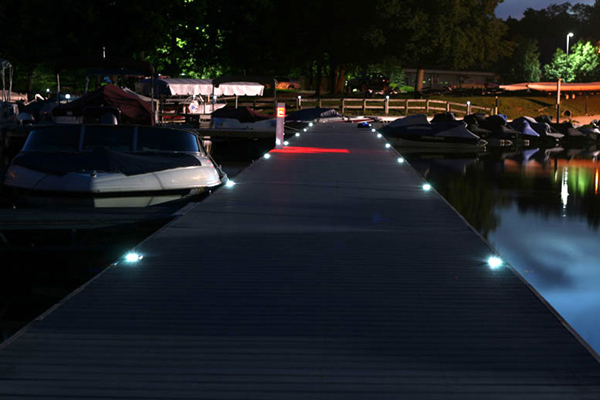
It’s a visually-striking layout that provides a sense of order and stability, creating a calming atmosphere in your dock space.
Alternatively, a circular dock light formation centers attention and is ideal for creating a sense of community and social interaction that’s excellent for a meet-up spot on your property.
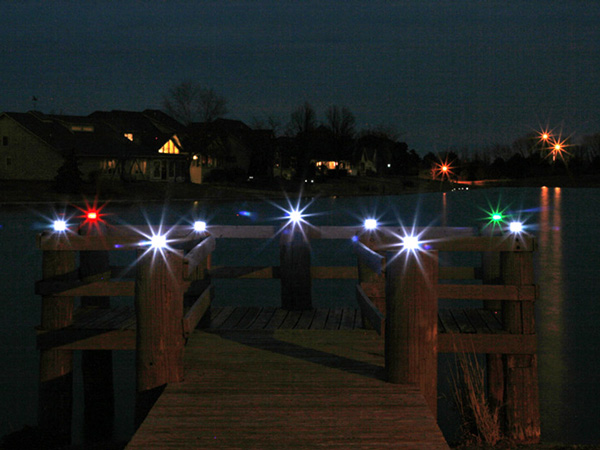
Question 27: Are Dock Light Fixtures Compatible With Smart Home Systems?
Yes, some dock light fixtures are compatible with smart home systems.
They leverage the same communication protocols behind Internet of Things (IoT) devices—Bluetooth & WiFi—to enable convenient functionalities such as remote activation and lighting control.
A fixture such as the Lumitec Scallop Surface Mount Deck Light enables remote color changing via a simple Bluetooth application. This is the same communication protocol smart home systems use to work with smartphones, hence the compatibility.
Even so, you need to establish before purchase that a dock light fixture is compatible with your specific smart home system. This entails checking details such as if your home system needs a bridging accessory to connect with your dock lights and if they use similar communication protocols.
Question 28: What Is the Average Cost of Dock Light Fixtures?
The average cost of dock lights depends on your type of fixture in relation to its features.
Entry-level dock lights with essential features such as a single-color light and standard illumination average $105. As such, they’re cost-effective and the ideal choice if you’re new to dock light fixtures and exploring options to discover their benefits.
Mid-range dock lights come with additional features beyond the essentials such as underwater operation and full-color changing. These fixtures average $500 and are an excellent choice if you’re looking for more functionality than entry-level options without premium pricing.
Premium-level dock lights offer the most functionality with advanced features, such as an integration capability with smart devices and home systems. As such, these fixtures cost upwards of $1,000 on average and need professional installation due to their complex nature.
They’re the ideal choice for when you’re more experienced with light fixtures and their benefits and wish to create a dream waterfront property with the highest quality standards.
Question 29: How Do Dock Light Fixtures Compare to Other Marine Lighting Solutions?
Comparably, dock light fixtures and other marine lighting solutions, such as boat navigation lights, share protective features that enable their function in maritime environments.
Both light types feature adaptations such as a watertight seal and rust-proof housing to overcome environmental challenges, including corrosion by seawater, physical damage from impact with water jets or splashes, and short-circuited components from water intrusion.
As such, dock light fixtures and other marine lighting solutions have comparable lifespans of between 1,500 and 25,000 hours, depending on their illumination technology (another commonality).
So, for example, your LED dock fixtures and LED navigation lights will have a general expected shelf life of 25,000 hours. At the same time, your incandescent dock fixtures and navigation lights will have a predictable lifespan of 1,500 hours.
The main point of difference between dock light fixtures and other marine lighting solutions is in their applications within the maritime environment.
Dock fixtures provide illumination specifically for docks, piers, and similar areas where vessels dock or unload cargo. As such, they’re typically mounted around the dock structure itself and include pilling and pathway lights.
On the other hand, marine lighting solutions encompass a broader range of applications within the maritime environment, from hulls to engine rooms to cabins.
As such, they’re more flexible in terms of mounting options, which include boat surfaces, hulls, walls, and even ceilings. Typical examples of marine lights are courtesy lights, navigation lights, and recessed fixtures.
The table below shows examples of courtesy, navigation, and recessed light fixtures available at Apex Lighting.
|
|
|
|
“The unit construction looks great. I have replaced 3 or 4 Aqua Signal lights that eventually corrode due to water intrusion. The Apex unit is completely sealed so I am hopeful it will last a long time.” — Larry B., Verified Buyer
Question 30: Can Dock Light Fixtures Increase Property Value?
Yes, installing dock light fixtures increases property value.
After the basics, such as your dock size and location, it’s the additional features, including dock light fixtures, that increase the appeal and value of your waterfront property.
These elements tap into our subjective perception of value, which potential buyers and renters use to evaluate a property in addition to the numbers. For example, ambiance, aesthetics, convenience, and a sense of safety.
By incorporating dock light fixtures, you’re able to feature all these perceptual, value-adding aspects in your waterfront property. You're also able to create a sense of style and personality that help your dock stand out in the marketplace, from rustic to contemporary to tropical.
Key Takeaway: The addition of dock light fixtures not only enhances the functionality and aesthetics of your waterfront property, but also can potentially increase its overall value.
Question 31: Are LED Lights Suitable for Dock Lighting?
Yes, LED lights are highly recommendable for dock lighting due to their high-energy efficiency and low-heat output.
Docks often require a significant illumination of 10 lumens per square foot to ensure proper visibility and safety. This requirement translates into high energy bills, which increase further with the standard practice of dock space all-night lighting.
As such, the 80% saving on energy LED lights offer, over incandescent bulbs makes them especially ideal for dockside illumination, where they provide cost savings for all-night illumination.
Meanwhile, because they generate less heat than incandescent bulbs, LED fixtures lower the risk of fire. This is particularly handy for lighting waterfront spaces with flammable materials, such as cargo storage.
Question 32: Do Dock Light Fixtures Have to Be Dimmable?
Dimming as a requirement for dock fixtures depends on your specific location and the local regulation and codes.
For a jurisdiction such as California, the 2019 Energy Code mandates that an outdoor light mounted at 24 feet or less (from the ground) be capable of continuous dimming through a range that includes 40 percent to 90 percent.
In other words, your fixture must be capable of adjusting its brightness smoothly between these two percentages.
This regulation aims to limit light pollution from all outdoor fixtures, including dock lights, and its effect on nocturnal wildlife, but it’s not a universal mandate. So, if you’re unsure, consult a lighting professional for more guidance on your local regulations for outdoor and dock fixtures.
Question 33: What Are the Energy Efficiency Considerations When Choosing Dock Light Fixtures?
How much lumen does your dock light produce per watt of energy?
The answer depends on your type of fixture, whether LED, incandescent, or fluorescent, but this is known as lamp efficacy and is the number one efficiency consideration when choosing between dock lights.
The general rule of thumb is to have the following minimum lumens for each listed watt rating to ensure your dock light is energy efficient.
| Watt Rating | Minimum Lumens | Efficacy (Lumen/Watt) |
| 40 | 450 | 11.25 |
| 60 | 800 | 13.33 |
| 75 | 1,100 | 14.67 |
| 100 | 1,600 | 16.00 |
| 150 | 2,600 | 17.33 |
Source: Energystar.govEnergystar.gov
Question 34: Can You Mix and Match Dock Light Fixtures?
Certainly, and in doing so, you’ll improve the overall aesthetic design of your dock space.
You don’t have to settle for one type of fixture for all your spaces. Mixing them up adds a touch of creativity and style that makes your property attractive to guests and even prospective renters and buyers.
For example, picture the aesthetic quality of mixing elegant low-glow pathway lights with vibrant underwater fixtures beneath them. They bond to create a cohesive opposites-attract design that grabs your gaze and holds it.
But this is just one approach to mixing fixtures. There are plenty more ideas to explore, such as combining functionality and ambiance with focused task lighting for workspaces and accents for recreational zones.
The video below shows the available color choices for the Pagoda LED Piling Light.
Question 35: Are Dock Lights Required by the Occupational Safety and Health Administration (OSHA)?
While OSHA lighting regulations don’t mention dock lights explicitly, they require that each work area and walkway be adequately lit. For example, an outdoor workspace must have a minimum of 10 lumens.
These are general working guidelines that also apply to environments such as docks and waterfront spaces. Their aim is to enhance the safety and well-being of employees and prevent visibility-related accidents such as collisions and equipment mishandling.
Therefore, dock lights aren’t directly required but are necessary for sufficient illumination of your property as per OSHA regulations. These include permanent dock fixtures mounted within various sections and portable, stand-in dock lights for emergency situations such as blackouts.
Question 36. What Types of Dock Light Fixtures Are Best for Saltwater Environments?
The best dock lights for saltwater environments are marine fixtures specifically designed to withstand high levels of salinity.
These fixtures come equipped with protective features such as rust-proof housing to withstand saltwater’s corrosive effect, which gradually creates cracks and openings on surfaces. Examples include powder-coated aluminum and marine-grade stainless steel.
Aluminum is inherently resistant to saltwater due to its naturally-occurring oxide layer that serves as a barrier. An additional powder coating creates another layer between the salt water and the metal, enhancing resistance to corrosion.
Marine-grade stainless steel contains chromium within its makeup that reacts with oxygen to create a protective chromium oxide layer. This inhibits direct contact with saltwater and enhances resistance to corrosion.
Saltwater dock fixtures also have watertight seals to protect their vulnerable internal components from physical and water damage and withstand submersion to specific depths. The seals have various ratings, majorly, IP68 and IP67.
- An IP68 rating represents complete protection from dust, resistance to 12.55 mm water jets from any direction, and a submersion capability of up to 9.8 feet.
- An IP67 rating signals complete protection from dust, resistance to 12.5mm of focused water pressure from all directions, and a submersion capability of up to 3.2 feet.
Question 37: What’s the Difference Between Solar-Powered and Wired Dock Light Fixtures?
The main difference between solar and wired dock light fixtures is in their sources of power.
Solar dock lights draw their energy from the sun during the day and store it for nighttime, typically in a lithium-ion battery because of its high energy density and long lifespan.
This makes solar fixtures more energy-efficient, sustainable, and the ideal lighting solution for off-grid locations and areas with unreliable power grids.
Wired dock lights, on the other hand, draw their energy directly from the grid for immediate use without onsite storage.
This makes them more consistent than solar dock lights, as they don’t experience cloudy days, and ideal for urban locations with a comprehensive approach to sustainability via renewable power grids.
At this level of sustainability, a power network depends on multiple sources of renewable energy to get around cloudy and low-wind days.
Want a quick summary instead? The table below examines how solar and wired dock lights perform under various conditions.
| Conditions | Solar Dock Light Performance | Wired Dock Light Performance | Optimal Choice |
| Cloudy weather | Performance might be reduced | Unaffected | Wired |
| Sunny weather | Optimal performance | Unaffected | Depends on other factors |
| Night-long usage | Performance depends on battery capacity | Unaffected | Wired |
| Off-grid location | Ideal, no access to grid needed | Requires generator or battery system | Solar |
| Urban location with reliable power grid | Performance unaffected, but may not be as cost-effective | Ideal, assuming infrastructure is in place | Depends on other factors |
Also Read: Solar Boat Dock Lights: What You Need to Know
Question 38: How Do I Maintain and Clean My Dock Light Fixtures?
The most effective way to maintain and clean your dock light is to make this practice a part of your bi-weekly schedule.
Dirt, sea growth, and barnacles collect rapidly on your dock fixtures, especially for underwater lights. Within weeks, they begin to impact performance, such as brightness and color intensity, as they grow to obstruct the lenses and weigh on the watertight seals, gradually loosening them.
Therefore, bi-weekly scrubbing using boat brushes and weekly inspections are highly effective at preventing accumulation and damage to your fixtures. However, the scrubbing must avoid harsh cleaning solvents such as acetone, which weakens the lenses over time.
Instead, mild detergents and a soft cloth are excellent at removing dirt and build-up without impacting your dock lights.
This approach not only ensures optimal working conditions for your fixture that enhance longevity but also enables early detection and intervention in the event of a malfunction. For instance, water penetration and failing bulbs.
Question 39: Can Dock Lights Be Automated or Controlled via Smart Devices?
Certainly, modern dock lights are capable of automation and remote control capabilities via smart devices for the convenience and efficiency they enable.
Automation takes various forms, and one notable example is solar dock lights. These fixtures feature in-built solar panels that detect a drop in UV radiation, indicating the transition to nighttime.
An automated system switches an onsite battery from charge to discharge, which powers the dock light on for visibility.
This automated process also works in reverse, for the transition to daylight, eliminating the need for manual deactivation while maintaining a timely schedule that saves energy.
Remote control using smart devices is a common feature of color-changing dock lights, which use communication protocols such as Bluetooth and WiFi to enable this integration.
These fixtures are designed for personalization and ambiance, and your smartphone serves as a calibration tool for preferences such as brightness, color, and even light effects.
Question 40: How Can I Ensure My Dock Lights Are Installed in a Way That Won’t Harm Local Wildlife?
Assess whether your dock light installation produces glare.
This is a common installation problem for dock fixtures where light rays travel upwards due to improper orientation. As a result, they become blinding at a distance and disorienting to nocturnal creatures like high-beam headlights on a road.
If this is the case, angle your fixtures to point downwards and eliminate any uplight. This is especially effective for elevated fixtures such as pole-mounted flood lights, which distribute light further.
Alternatively, if angling your fixture isn’t possible due to a fixed mounting design, use shades to block any uplight emission and minimize glare. However, don’t use insulating materials such as wood, which will cause overheating and damage your dock light on top of posing a fire hazard.

